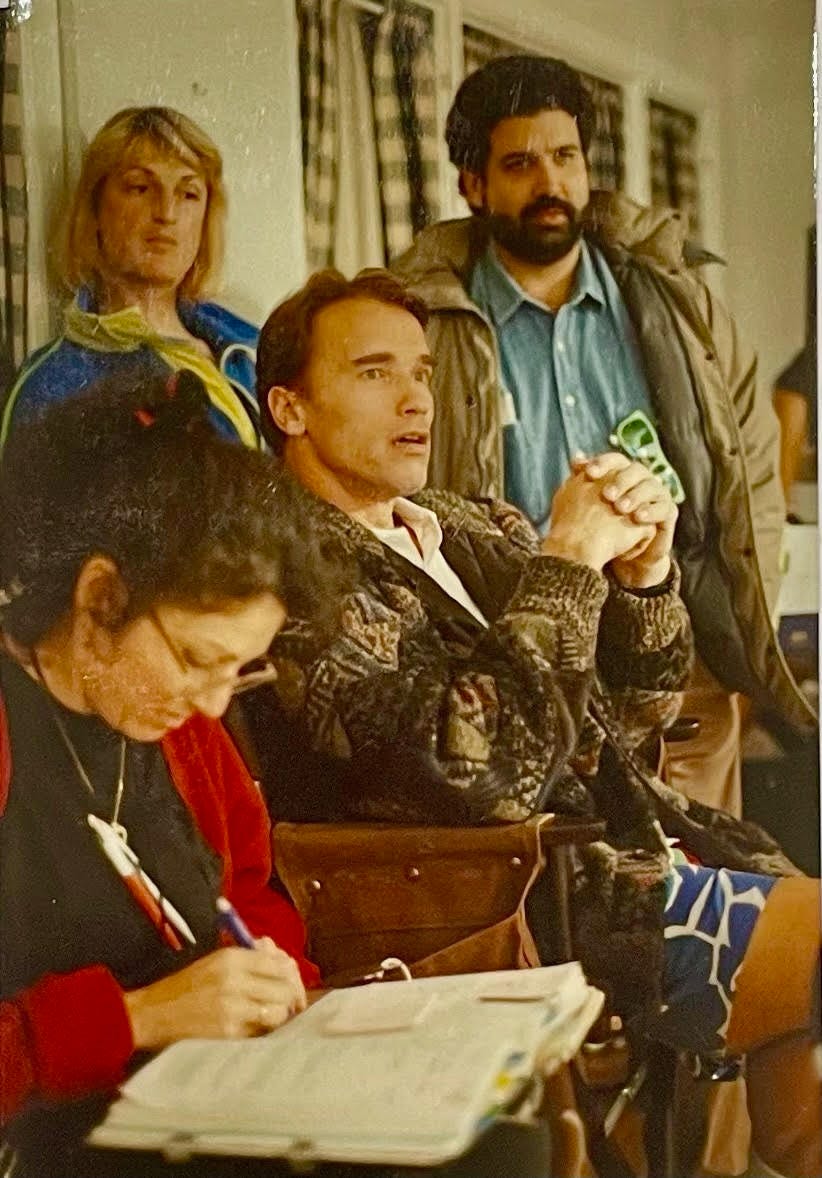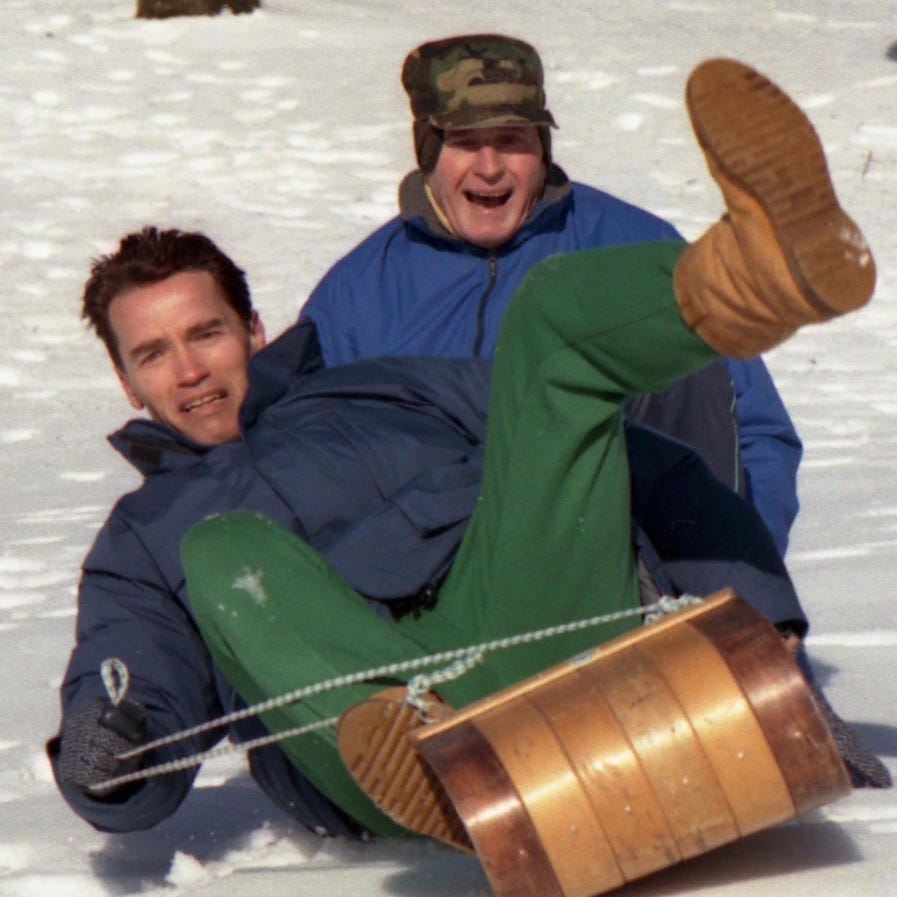A New Year's Lesson From Schwarzenegger
Arnold Schwarzenegger's only directorial turn, and a lesson in trying.
About four years ago, I was quarantining in my parents’ attic. This was the height of COVID, and I was dead set on being home for the holidays. And for some reason, I was reading Arnold Schwarzenegger’s IMDb page. Which is how I learned he once — one time ever — directed a feature film:
The 1992 made-for-tv remake of the 1945 Christmas classic, ‘Christmas in Connecticut.’
I, of course, watched it immediately. It was not great. And genuinely strange in a way where I was left wondering how, exactly, this had happened. Earlier this year, I picked that question back up, made some calls, talked to about a dozen people involved in the film, and wound up with the extremely zany, true story of the making of Arnold Schwarzenegger’s Christmas in Connecticut.
You can listen to the resulting episode on Revisionist History, or read a different version of the story I wrote for Vulture.

The story revolves around journeyman made-for-tv producer Stan Brooks, who is making a small Christmas film on basic cable when he gets a call from Schwarzenegger’s agent informing him that Schwarzenegger would like to direct the movie. From there, all hell breaks loose.
The guys who wrote Commando (1985) come onboard to punch up the script; a scene where lead actor Kris Kristofferson is doing chin-ups in a mountain cabin is added to the very top of the film; somehow Mitch Albom (the bestselling author of Tuesdays With Morrie) is hired to write a closing song; and meanwhile the crew is standing by dumbstruck as things go off the rails. You can read / listen to the stories linked above for the play-by-play on how this happened. And you can read on for some additional meditations on its New Year’s implications.
Stan and Schwarzenegger’s agent at the time, Lou Pitt, had similar theories about why, exactly, Schwarzenegger decided he wanted to direct, and to direct this film in particular. He was 44, with young kids (one of them brand new) having just wrapped up shooting on Terminator 2. Knowing he wouldn’t be an action hero forever, he saw two paths laid before him:
Become a director.
Become a politician.
So the best way to test option one without jeopardizing option 2 was to direct a low-budget, family friendly movie on a cable network not a lot of people even had access to. And lo, a Christmas miracle transpired.
It’s clear from the quality of the film and his stint a decade later as the 38th governor of California that Option 2 won the day. And, in a twist, Governor Schwarzenegger appointed Christmas in Connecticut Executive Producer Stan Brooks to the California Film Commission, where Stan became a key part of the lobbying efforts to pass the very first California film tax credits, a program that’s been drawing a lot of attention lately as California once again hemorrhages film production.
Stan made sense to Schwarzenegger as an advocate for tax breaks because shooting in California tended to be too expensive for him. He’d typically shoot in Canada or in a state like New Mexico that had a strong incentives program. It was only through Schwarzenegger’s insistence and aid that Christmas in Connecticut wound up shooting in Los Angeles, hence the many photos of Schwarzenegger, on-set, surrounded by fake snow, wearing shorts.
The tax credits were like a bandaid to keep together a local industry that’s been in one form of crisis or another for the past two decades — an attempt to keep Hollywood an industry town, rather than merely an homage to a past when they still made movies in California. In that aim, it is an imperfect tool, but better, I think, than nothing.
Thinking about the tax breaks unlocked the meaning of the story for me. In the end, this became for me a story about the joy of making things — even bad things — and how people overcome the many obstacles on any given creative journey. The economic ones tend to be a little more insoluble. But a lot of people stop themselves before the market can with their own self-consciousness — the fear of trying something new, or embarrassing themselves.
Arnold Schwarzenegger had no such qualms. He barreled into this experience with decidedly mixed results. Yet he had a sense of humor about himself, and it was infectious. People had a blast making this movie. That counts for a lot. Being a person who just tries things is definitely how you wind up making an entirely forgettable cable TV Christmas film. It’s also how you wind up becoming Mr. Olympia.

This was a year where I got to make a lot of things. The ones I’m proudest of (other than this Arnold Schwarzenegger story, obviously) are the nine-part series Malcolm Gladwell & I made about the 1936 Olympics, and in particular my two-parter deconstructing a made-up story about Jesse Owens befriending a Nazi at the Games.
I’m also proud of this story about a conspiratorial right-wing organization run by a candy tycoon trying to take over the Parent-Teacher Association in the 1960s.
In your year ahead, I wish you the heedless joy of Arnold Schwarzenegger attempting to reanimate a Christmas classic. Whatever you’re after, good luck getting there.
And see you in the New Year.









Ben, listening to this episode of Revisionist History was absolutely delightful. My dad taped the made-for-TV remake, I would guess, very close to the year it was released. I do not remember a Christmas season when I have not watched this film. Watching it is a tradition for me and my sisters, and it's not truly Christmas for us until we've seen Kris Kristofferson declare with a mouthful of toothpaste, "I heard a woman scream." I thoroughly enjoyed learning so many new bits of information about this film. Thanks for delving into it! (I stumbled across the original MUCH later, and I agree, it's a superior film in every respect. But gosh darnit, the 1992 version will nostagically always be my favourite Christmas movie.)